The Mysterious yet Interesting Realm of Black Holes is full of many marvels and wonders. The cosmic events, incredible gravitational pull, and secrets of Black Holes from space are captivating aspects of the universe that are to be learned, found, and explore.
Well, you often have heard the very scientific definition of a black hole. But I would make an explanation in an easy way so that anyone can understand the concept.
Imagine a place in space with gravity so strong that not even the fastest object in the universe, light, can escape its grip.
Black Holes are this remarkable and powerful phenomenon. Black Holes are created when a massive star reaches the end of its life and experiences gravitational collapse. Black Holes are real.
Since so much mass is jam-packed into a little area, a black hole has a tremendous gravitational pull.
In simple notes, Let us suppose a star that has run out of nuclear fuel. This is just for understanding purposes. When this occurs, gravity causes the core of the star to collapse under its own weight. A black hole is produced when the collapse is so intense that it forces all of the matter into space.
This is a very simple concept to understand the basics. Nonetheless, several questions arise regarding Black Holes and it is not as simple as it is described and as its name shows there are several mysteries.
Humans have discovered some, but still there is a long way.
If we talk about the very first time of its discovery, it is not that old. Even a century ago, no one knows about it. So, what made the discovery of Black Holes?
It is the name that resounds in the universe of science and it is Albert Einstein.
Yes, because of the theory of relativity of Einstein, the discovery of Black Holes was made.
What is the theory of relativity of Einstein?
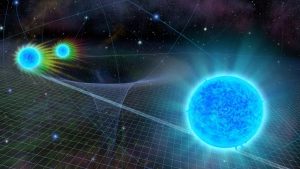
Relativity is the main thing here, focus on that!
Albert Einstein created a scientific framework known as the theory of relativity at the beginning of the 19th century. The special theory of relativity and the general theory of relativity are the two main theories.
Theory of general relativity
The general theory focuses on how gravity affects the curvature of space-time. The passage of time can be indirectly impacted by gravity.
According to Einstein’s general theory of relativity, gravity is a result of the curvature of space-time brought on by the presence of mass and energy rather than a force. The motion of other objects is impacted by the curvature that objects with mass or energy cause in the space-time fabric.
Now, how does the Theory of relativity General explain gravity’s effects on time?
In the theory of relativity Einstein, The idea of gravitational time dilation is how it works.
According to gravitational time dilation, time moves more slowly in larger gravitational fields because gravitational forces impact energies as well.
Well, it would be difficult to understand like this. Why not take an example?
Let us look at an illustration to better understand this idea of the theory of relativity general:
Consider two observers in a different gravitational field according to the theory of relativity general. One observer is onboard a spacecraft far away in the universe, where gravity is weaker, while another observer is on the surface of the Earth.
Time moves a little bit more slowly for an observer on Earth’s surface than it does for another observer in the spacecraft because of the Earth’s mass’s effect on the curvature of space-time. Simply, clocks tick more slowly when they are in an area with a higher gravitational field, such as close to the Earth.
As the gravitational field is greater, the time dilation effect becomes more noticeable. Time would pass much more slowly for an observer in a spaceship if he were close to a large object with enormous gravity, such as a black hole.
Therefore, the theory of relativity general connects gravity to the curvature of space-time.
Theory of special relativity
The theory of relativity special states that when an object is traveling rapidly relative to another object, time appears to be progressing more slowly for the moving object than it does for the stationary object.
In simple words, relative to an observer at rest, time slows down for objects in motion in the concept of the theory of relativity special.
The idea that an object’s motion might affect the passage of time was first proposed by the theory of relativity special. Time dilation is the term for this occurrence.
Again let us understand with an instance.
Consider yourself seated in a train that is moving gradually along the rails. You notice another train traveling side by side with yours when you look out the window. A person is reading a book and drinking coffee inside that train.
Now here comes the twist: what if both of you claim that you are the one who is moving while the other person is stationary? Who is correct? Well, you both are, according to the theory of relativity!
Black holes and the theory of relativity
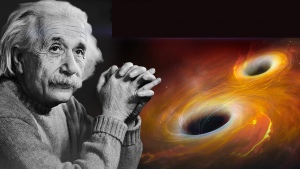
The above detail goes for the theory that is related to Black Holes. Now, Einstein simplifies it by visualization of a space-time fabric. Imagine all the planetary objects are placed on this and those having higher mass are bending down this fabric more.
Consider space-time as an expansive, elastic fabric. A depression or curve is made in the fabric when heavy objects, such as planets or stars, are placed on it.
The depth of the dent is directly proportional to the mass of the object. It means that more heavy objects have a higher curvature. What we understand as gravity is the curvature of space-time.
Imagine now that small-sized objects are continuing across this fabric. They follow the curve or bending of fabric; therefore they will certainly fall towards the larger things because their weight has made a deep curve. This shows how gravity causes objects to be drawn together and make us understand the concept related to black holes and the theory of relativity of Einstein.
When this fabric is bending, not only physical bodies are attracted towards it, but time is also getting dilated and every possible form of energy like sound, heat, or light has the impact of gravitation.
They interact with the space-time bending caused by large objects. For example, light traveling by a large object will travel along a curved route because of the curvature of space-time. This is how gravity is witnessed to bend light.
The theory of relativity general also states that gravity has an impact on time itself in addition to how objects move across space and time. Time moves more slowly in regions with larger gravitational fields than in regions with weaker gravitational fields because of the greater curvature of space-time in these regions.
To cut a long story short for Black Holes and the theory of relativity Einstein, practically everything in the universe is impacted by gravitation. It affects the movement of energy and light and bends the space-time fabric. Even time is affected by it; in higher gravitational fields, time moves more slowly.
So it can be said that there could be such objects in the universe with extremely higher gravitational force to unbelievable amounts that it can completely absorb light. If they completely absorb light, then definitely they are black. They would be completely invisible as light would also incapable of any escape from there. These are the Black Holes.
An important thing to note is that Einstein did not exactly knows it is Black Hole, he believes in the theoretical concept. Even the first time word Blackhole was used in a magazine in 1964.
The general theory of relativity predicts the existence of Black Holes, objects with extremely strong gravitational fields, in the universe.
They produce a gravitational field from which nothing, not even light, can escape because they are so large and dense. They do neither emit nor reflect any visible light, which is why they are referred to be black holes.
A black hole’s powerful gravitational attraction creates an area called the event horizon where the escape velocity, the speed needed to break free of the gravitational pull exceeds the speed of light. Light, like everything else that crosses this event horizon, is drawn in and unable to escape.
Since Black Holes cannot emit any light or other electromagnetic radiation, they are therefore undetectable to our telescopes and detectors.
The remains of enormous stars that have run out of nuclear fuel and gravitationally collapse can become Black Holes. At the black hole’s core, the star’s mass condenses to a singularity, a point of infinite density. The event horizon, whose gravitational pull is so intense that nothing can escape it, surrounds the singularity.
Although Black Holes cannot be seen directly, their effects on nearby matter and light can be used to indirectly identify their presence.
Also, not every star can be a black hole because there is a limitation. Let us take the example of our famous star, The Sun.
Can a sun be a black hole ever?
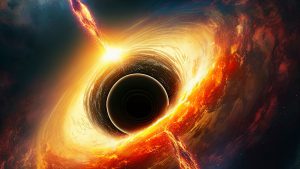
No, a loud no!
Black Holes cannot form around the Sun. There is a specific value related to the formation of Black Holes.
Nuclear fusion, which occurs when hydrogen atoms come together to make helium and release massive quantities of energy in the process, is what powers stars like the Sun. The Sun’s stability and ability to resist collapse under its own weight are maintained by the energy, which generates an outward pressure that opposes the pull of gravity.
The Sun will eventually run out of nuclear fuel as it gets older. It will alter at this point, grow into a red behemoth, and eject its outer layers. Over the course of billions of years, the Sun’s leftover core, known as a white dwarf, will gradually cool down. It will be a white dwarf, not one of the black holes.
A star must be far heavier than the Sun to develop into a black hole. A supernova explosion occurs when big stars, which are typically more than three times the mass of the Sun, run out of nuclear fuel. The core of stars then experiences a collapse caused by its own gravity to create black holes.
The mass of the object is a key component in the development of Black Holes. Sun’s mass is insufficient to cause this collapse and create a black hole. Instead, it will go along the earlier indicated evolutionary route, eventually evolving into a white dwarf.
Therefore, even though the Sun will eventually change and pass away as a white dwarf, it lacks the mass needed to turn into a black hole.
That was all for the existence of black holes. Now it is also important to know about its type.
Stellar black hole
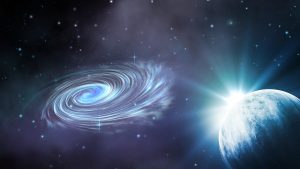
This is the common type of black hole formed by stars.
Massive stars gravitationally collide to cause stellar Black Holes. A stellar black hole is created when a star’s core collapses and becomes incredibly dense and compact.
A supernova explosion is a potent and energetic event in which a stellar black hole is created. Nothing, not even light, is able to escape from the star’s gravitational field as the star’s core collapses.
Supermassive black hole
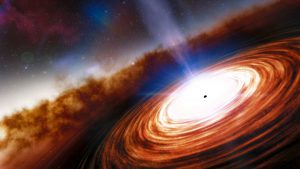
As the name says, these are the enormous types.
These are the largest sort of Black Holes and are supermassive, with masses that can reach millions to billions of times that of the Sun.
They are found at the cores, including that of our own Milky Way. Supermassive black hole-creation mechanisms are still being studied
Intermediate black hole

Supermassive Black Holes’ size lies somewhere in between stellar and supermassive Black Holes.
Although the precise process by which intermediate-mass Black Holes emerge is still unknown, they may be the direct collapse of enormous gas clouds or the merger of smaller Black holes.
The masses of such types can have masses that are millions to billions of times greater than the Sun.
Primordial black hole
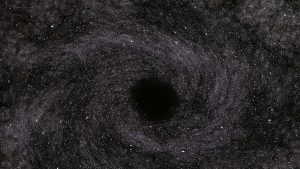
These are the Theoretical ones and exist in theories as of yet.
The fact that primordial Black holes may have a wide range of masses, ranging from as tiny as a single atom to possibly far larger than stellar Black Holes, is one interesting feature of these objects.
However, the existence of primordial Black Holes has not been clearly established due to their hypothetical character and the difficulties associated with their discovery.
Some interesting points
- A black hole is not truly a black hole in the sense of a visible hole. It is an area of space where gravity is so intense that nothing can escape from it, not even light. But that does not hint that it is entirely dark. An accretion disk, a luminous disk of stuff that surrounds a Black Hole frequently, can be extremely bright and glittering.
- Because of their strange characteristics, Black Holes are incredibly interesting. They have an event horizon, which looks like an invisible wall surrounding them. This line cannot be crossed again after it has been crossed. It is still challenging to investigate what is happening within a black hole since we can’t see past the event horizon.
- Furthermore, Black Holes have a singularity, a point of infinite density at their center. Our existing physics theories fail near the singularity; hence we are unable to fully understand what occurs there.
- In simple terms, the principles of physics do not work there, making it seem like a forbidden territory. Time and space are changed and no longer work as they should.
It is like a cosmic riddle that we have not yet cracked.
The invisibility of Black Holes is one of their amazing properties. It is like a thing exists, but not exists. Black Holes are in effect veiled from direct observation because light cannot escape their gravitational pull.
Now, only one picture of a black hole exists that was taken with an Event Horizon Telescope in 2019, nearly 100 years later of its theoretical existence.
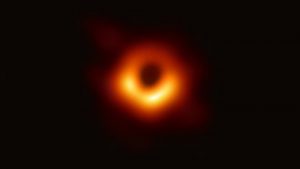
Despite the existence of black holes being predicted by Albert Einstein’s theory of general relativity, scientists had never directly detected one until 2019. The Event Horizon Telescope (EHT) team did and made history by taking the very first picture of black holes.
The supermassive black hole at the heart of the galaxy Messier 87 (M87) is depicted in the 2019 image. The EHT is a global network of telescopes.
The picture revealed a dazzling ring-like structure encircling an area of darkness in the center, which is referred to as the black hole’s shadow. The high gravity of the black hole bends and captures light from the hot gas in the area, creating this ring.
The ending note
This was the journey to space and it’s one of the mysterious yet interesting parts, Black Holes.
Just how amazing the wonders of space are!
The vastness of space and galaxies has the greatest of the secrets that are still to discover.
Black holes and their wonders are fascinating subjects.
Black holes are only a mark of the surface of the marvelous mysteries that lie hidden within the galaxies and spreads of space.
So, how do you feel about the black hole universe? What have you discovered? What unanswered questions remain?
Let us all explore the mysteries of the universe like Black holes!













